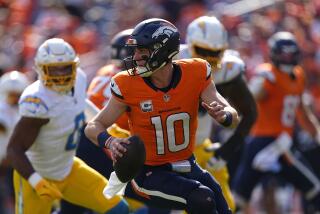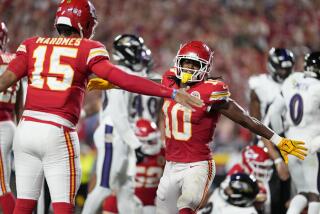SUPER BOWL XXI : COMMENTARY : Giants Had Right Plays at the Right Times, Too
At the critical moment of the game, the New York Giants were ready with the right play, the play they had to make to beat the Denver Broncos in Sunday’s Super Bowl.
This was a third-quarter quarterback sneak--not a garden-variety sneak, but a special one.
It wasn’t even the gamble it seemed to be when Coach Bill Parcells gave his team the green light to go for it.
For it was a play with three essential components, all carefully executed--and as a series guaranteed to befuddle the Broncos:
--First, on fourth and one at the New York 46, the Giants lined up in punt formation with backup quarterback Jeff Rutledge on the field as a blocking back.
--Next, Rutledge moved up under center, and, playing quarterback now, began a long count that made the Broncos, and almost everyone else, believe he was trying to draw them offside.
--Proud of themselves for resisting, the Broncos were still standing there flat-footed when, just before time ran out on him, Rutledge took the snap and easily gained the needed yard.
The Giants needed such a play to get them going at a time when they were losing, 10-9. After Rutledge made it, they drove to the go-ahead touchdown, 16-10, en route to a final score of 39-20.
The Giants didn’t win as easily as it might seem in retrospect. They needed another trick play to put Denver away--and Parcells was ready with this one, too.
They were beating Denver at the time, sure enough, but they didn’t have it won when Parcells chose a perfect moment for the flea-flicker pass he’d had in mind all week.
It was second and six late in the third quarter when quarterback Phil Simms handed off to running back Joe Morris, who briefly faked a line buck before making a lateral pass back to Simms, who fired far down the field to second-string wide receiver Phil McConkey, who came to rest 44 yards later at the Denver 1-yard line.
The touchdown that followed put the Broncos on the airport bus. They’d still had some kind of chance when Simms unloaded. Afterward they were through, 26-10.
Denver quarterback John Elway played to his exceptional potential in his first Super Bowl after the Giants had come to town with the better team.
Unlike the Broncos, the Giants have the capacity to both run and pass effectively. So, all along, it had appeared to be only a question of time for the Giants--unless Elway could open a sizable enough lead to make them nervous.
And Elway played well enough in the first half to get that kind of lead.
He could have had Denver ahead by 24-9 or even 28-9--instead of 10-9--with a team around him. But, for one thing, the Broncos kept taking the ball out of his hands in scoring position.
Although they demonstrated instantly that they couldn’t move against the Giants with any of their running backs, they kept trying, and it kept costing them.
There were three damaging interludes for the Broncos in the first half:
--First, in the first quarter, from shotgun formation on third and seven, Elway passed successfully to Mark Jackson for 24 yards to the Giant 39. But after another pass gained five yards, the Broncos elected to run on second and third downs, setting up a field goal.
--Next, Elway opened the second quarter with a scrambling pass to wide receiver Vance Johnson for 54 yards to the Giant 28. But after three more passes moved the Broncos to a first down at the New York 1, they again chose to run the ball on three successive plays, losing five yards. They also missed an easy field goal there, but it was the running-play calls that hurt the most.
--Finally in the first half, Elway made the kind of play that only he can make, a delayed rollout to the left followed by a long throwback pass to a receiver running a square-out to his right. When Steve Watson fielded it for 31 yards, the Broncos were at the Giant 32, and soon they were at the Giant 16.
This time on third and 5, Elway threw. But in that emergency, the Broncos weren’t ready with the kind of third-and-five pass that could succeed, and tight end Orson Mobley was well covered. Again, the Broncos missed an easy field goal.
This was a game in which, except for Elway, the Denver offense at no time resembled a Super Bowl offense.
The New York defense will get the credit for halting Denver in the first half. But if the Broncos were going to run, they were going to make that defense look good.
It might have been a different game if the Broncos had unleashed Elway for another touchdown or two. The Giants probably wouldn’t have had the courage to call a fourth-down quarterback sneak if they had been, say, two touchdowns behind.
The Most Valuable Defensive Player for the Giants was linebacker Carl Banks, who was seen once more in a better all-around game than Lawrence Taylor.
The most damaging sack against Elway was the work of nose tackle Jim Burt.
Although the sack was applied by defensive end George Martin, who caught the Denver quarterback for a safety in the second quarter, it was Burt’s rush up the middle that made it possible.
When he got in there, Burt was standing where Elway had intended to be. Elway wanted to step forward but couldn’t, and Martin nailed him.
For much of the first half it was a classic modern football game. Both sides came out passing, and because both were in zone defenses, the quarterbacks both completed most of their throws in the first 1 1/2 quarters, reaching receivers who were running along in the sparsely covered short zones.
But in the decisive third quarter, the Giants’ kicking game gave them consistently good field position. At the same time, it put the Broncos in the unsatisfactory field position that was to change Elway’s luck.
Opening the second half, Denver’s Rich Karlis kicked off only to the Giants’ 10-yard line, enabling them to run it back nearly to the 40 at the start of their go-ahead scoring drive.
Next, the Giants ran back Mike Horan’s line-drive Denver punt to the Denver 36, setting up another New York touchdown drive.
Meanwhile, Raul Allegre’s Giant kickoffs were carrying at least to the goal line, forcing Elway to start his three third-quarter series at the Denver 24-, 20- and 20-yard lines.
After dominating the first half, Elway didn’t make a first down in that quarter.
This was Giant quarterback Simms’ seventh straight big game for the Super Bowl champions since Dec. 1, when he turned a corner in San Francisco.
Since that night, when the Giants fell behind in the first half, 17-0, and pulled it out on Simms’ throws, 21-10, he has delivered 16 touchdown passes and has only been intercepted four times.
Simms triggered Sunday’s Giant performance, but he wasn’t the difference.
The difference was Parcells’ coaching--particularly the three trick plays he thought of in the third quarter, each instrumental in a scoring drive.
The first and third of these plays were the quarterback sneak and the fleaflicker. The second was a nine-yard run by Morris on third and five setting up a Giant field goal.
That time, the Broncos were in some kind of nickel defense with no big man at defensive right end--neither a lineman nor a linebacker. And, for the first time in this game, Morris ran that way and made the first down handily.
Leadership is a lot of what the Giants obviously have these days. Their general manager, George Young, has brought in the players. And in his first NFL championship game, Parcells had them ready. The Broncos only had Elway.
More to Read
Go beyond the scoreboard
Get the latest on L.A.'s teams in the daily Sports Report newsletter.
You may occasionally receive promotional content from the Los Angeles Times.










